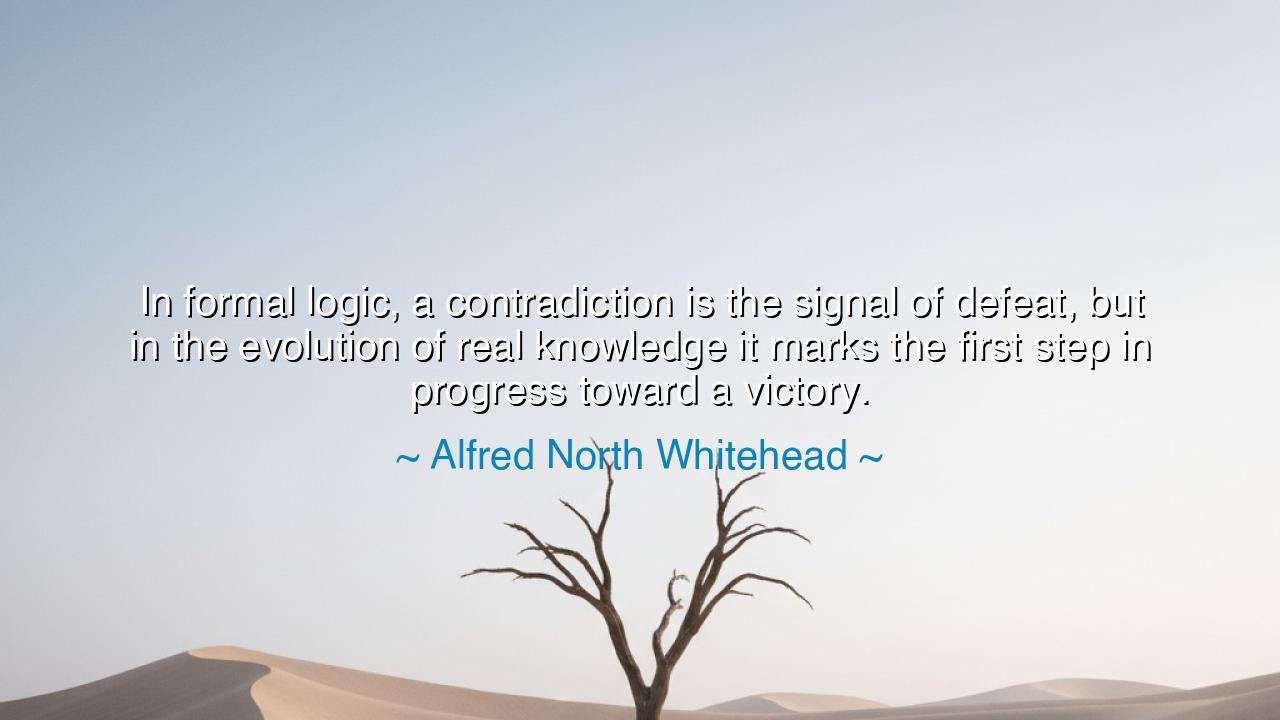
In formal logic, a contradiction is the signal of defeat, but in
In formal logic, a contradiction is the signal of defeat, but in the evolution of real knowledge it marks the first step in progress toward a victory.






Hear, O lovers of wisdom, the words of Alfred North Whitehead, the great philosopher of reason and process, who declared: “In formal logic, a contradiction is the signal of defeat, but in the evolution of real knowledge it marks the first step in progress toward a victory.” In this statement lies a profound truth: that what seems ruin to the rigid thinker may, to the seeker of truth, be the doorway to discovery. For though logic demands consistency, life and learning demand growth—and growth is born when old truths are broken open.
In the halls of strict logic, to stumble upon a contradiction is to fall. The system collapses; the proof is undone. But in the realm of living knowledge, a contradiction is not the end—it is the beginning. It reveals that something we thought complete was in fact partial, that our vision was too narrow, our understanding unfinished. The contradiction is a light flashing in the dark, saying: “Here lies the limit of what you know. Beyond this boundary waits a greater truth.”
Consider the example of Copernicus and the astronomers of his time. For centuries, the earth was believed to sit unmoving at the center of the heavens. Yet again and again, contradictions arose: the wandering of the planets, the backward motions that could not be reconciled with perfect circles. To many, these contradictions were a defeat—a confusion to be patched with more and more complex calculations. But to Copernicus, they were the sign of a new path. Out of contradiction came revolution: the sun, not the earth, was the center, and from that contradiction grew the victory of modern astronomy.
So too with Einstein, who beheld the contradictions between Newtonian mechanics and the behavior of light. To cling to the old system was to accept defeat; to confront the contradiction was to advance. Out of the tension between time, space, and motion was born the theory of relativity—a deeper harmony, discovered through the very cracks in the old framework. What had seemed a ruin became a triumph, because contradiction was embraced as the herald of transformation.
The teaching of Whitehead’s words is thus: do not fear the contradictions of thought, nor the moments when what you believe is shaken. These are not the signs of final defeat, but the beginnings of growth. Just as the seed must break before the plant emerges, so must the shell of our old ideas crack before the new truth can live. The wise do not flee from contradiction; they lean into it, asking what deeper unity lies hidden within.
The lesson for you, O listener, is clear: when you encounter contradiction in your own learning or in the world, do not despair. Do not patch over the cracks in your understanding with excuses, nor silence the voices that trouble your certainty. Instead, take contradiction as a teacher. Ask: what new knowledge does this reveal? What greater vision must I now seek? For it is through such struggles that you rise from the lesser truth to the greater.
Practical action lies before you: welcome questions, even when they unsettle you. Read widely, seek perspectives unlike your own, and when contradictions arise, do not turn away. Reflect, investigate, and let them sharpen your mind. For every contradiction embraced and explored is the first step toward a new victory—the victory of deeper knowledge, clearer sight, and truer wisdom.
Thus remember Alfred North Whitehead’s words: in rigid systems, contradiction signals defeat, but in the journey of the mind, it is the doorway to progress. Walk through that doorway boldly, and you will find that every clash of ideas can become the forge of truth, every defeat the beginning of a triumph.






AAdministratorAdministrator
Welcome, honored guests. Please leave a comment, we will respond soon